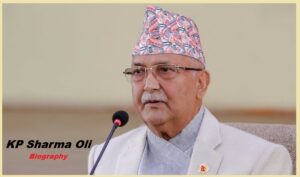KP Sharma Oli Biography – Early Life, Political Career, Achievements and Legacy

KP Sharma Oli
Introduction
Khadga Prasad Sharma Oli — popularly called KP Sharma Oli — is one of the most recognisable figures in current Nepali politics. This K.P. Sharma Oli biography traces his adventure from a rural upbringing and years of imprisonment to becoming the Prime Minister of Nepal multiple times. It highlights his youth, political rise, achievements, controversies, private lifestyles and the legacy he leaves behind for Nepalese democracy.
| Field | Details |
|---|---|
| Full Name | Khadga Prasad Sharma Oli (commonly known as KP Sharma Oli) |
| Date of Birth | 22 February 1952 |
| Place of Birth | Terhathum District, Nepal |
| Nationality | Nepali |
| Profession | Politician |
| Political Party | Communist Party of Nepal (Unified Marxist–Leninist) – CPN-UML |
| Key Position | Former Prime Minister of Nepal |
| Term as PM | First Term: October 2015 – August 2016Second Term: February 2018 – July 2021 |
| Known For | Leading Nepal during the adoption of the new Constitution, strengthening Nepal’s ties with China and India |
| Spouse | Radhika Shakya |
| Awards / Recognition | Influential leader in Nepalese politics, major role in post-earthquake reconstruction |
Early Life
KP Sharma Oli was born on 22 February 1952 in Iwa, a hilly village in Terhathum District in eastern Nepal. He grew up in a modest farming family. His mom died at the same time he had become a toddler, and his father moved the family regularly in search of higher prospects. This tough youth fashioned his character — disciplined, self-reliant and politically aware at an early age.
Despite limited schooling, Oli developed a deep interest in Marxist thoughts and Nepal’s underground leftist movements. By his overdue teens, he grew to be involved in student politics and networking, which set the level for his destiny control.
Formative Political Years
During the 1970s, Nepal turned into a republic under the Panchayat system (a celebration, a much less political device). Oli joined the communist movement, which was unfavourable to it. In 1973, he was arrested for his activism and may have spent about 14 consecutive years in jail under harsh conditions. This long incarceration has become a defining chapter in the K.P. Sharma Oli biography, turning a younger activist right into a hardened political strategist and giving him the image of a steadfast fighter.
In jail, he continued to read political ideas, debated with fellow detainees and constructed networks that later helped him advance in the Communist Party of Nepal (Unified Marxist-Leninist), also called CPN-UML.
Political Rise
After his launch in the late 1980s, Nepal began heading closer to a recovery of multiparty democracy. Oli acquired a seat in parliament from Jhapa constituency and shortly ended up one of the CPN-UML’s most visible leaders. His simple-spoken style, organisational skills and reputation as a former political prisoner gave him credibility among cadres and voters alike.
By the early 2000s, he had held several ministerial portfolios, which included Home Affairs, and was considered a key participant in shaping the party’s guidelines on federalism, protection, and improvement.
Prime Ministerial Tenures
KP Sharma Oli served as Nepal’s Prime Minister on more than one occasion. The desk underneath summarises his essential tenures:
| Term | Period | Key Highlights |
| First Term | Oct 2015 – Aug 2016 | Took office after the promulgation of Nepal’s new constitution; faced an economic blockade at the Indian border; initiated trade and transit agreements with China. |
| Second Term | Feb 2018 – July 2021 | Led a majority government under a unified left alliance; promoted the slogan “Prosperous Nepal, Happy Nepali”; focused on infrastructure and foreign policy diversification; dissolved Parliament twice amid disputes. |
| Third/Fourth Term | 2024 – 2025 | Returned to power in a coalition, confronted mass protests and resigned in 2025. |
These stints in office gave Oli both admirers and critics. Supporters credit him with taking ambitious alternatives to claim Nepal’s sovereignty and releasing ambitious infrastructure plans. Opponents accuse him of centralising energy and undermining constitutional norms.
Major Achievements
Some critical aspects of achievements regularly referred to within the K.P. Sharma Oli biography consist of:
- Leadership beneath the new charter: As the primary Prime Minister after the 2015 constitution, he oversaw the preliminary implementation of federal governance structures.
- Diversifying overseas circle of relatives members: During the 2015–sixteen blockade, Oli moved quickly to sign transit agreements with China, decreasing Nepal’s over-dependence on India for trade routes.
- Infrastructure force: His control announced primary road, rail and power initiatives under the banner of “Prosperous Nepal, Happy Nepali.”
- Party unification: He held a treasured position inside the 2018 merger between CPN-UML and the Maoist Centre, forming the Nepal Communist Party (regardless of the fact that the merger later collapsed).
Controversies and Criticisms
Like many strong leaders, Oli’s tenure was not without disputes:
- Centralisation of power: Critics allege he sidelined competitors and used constitutional loopholes to dissolve Parliament.
- Handling of the COVID-19 pandemic: His authorities faced complaints over delays in vaccines and coordination.
- 2025 Protests and Resignation: Large demonstrations erupted over governance problems, which ultimately led to his resignation.
These episodes add complexity to the K.P. Sharma Oli biography, portraying him as a pacesetter who conjures up loyalty but also polarises opinion.
Personal Life
K.P. Sharma Oli is married to Radhika Shakya, who has additionally been active in social and political circles. Away from the political region, he seems to have a fondness for poetry and song, and every so often cites literature in his speeches. His personal journey from a small hill village to the pinnacle workplace of Nepal resonates with many normal Nepalese.
Electoral & Career Snapshot
| Detail | Information |
| Full Name | Khadga Prasad Sharma Oli |
| Date of Birth | 22 February 1952 |
| Birthplace | Iwa, Terhathum District, Nepal |
| Time in Prison | Approximately 14 years (1973–1987) |
| Parliamentary Constituency | Jhapa (multiple terms) |
| Prime Ministerial Terms | 2015–2016, 2018–2021, 2024–2025 |
Leadership Style – Strengths and Weaknesses
Strengths
- Decisive and assertive management fashion.
- Ability to mobilise party people and preserve a robust public persona.
- Willingness to reorient foreign places insurance to diversify Nepal’s options.
Weaknesses
- Accused of being illiberal toward dissent.
- Struggled to keep unity within huge coalitions.
- Mixed document on implementing ambitious improvement initiatives.
Legacy and Impact
Any balanced K.P. Sharma Oli biography ought to speak to his legacy. Oli is visible as a transformative but controversial chief. On the one hand, he reinforced Nepal’s negotiating position with effective neighbours and championed infrastructure improvement. On the other hand, his tendency to consolidate energy and his coping with internal birthday celebration democracy have left a divided political landscape.
For destiny generations, Oli’s career offers training on both the opportunities and pitfalls of strong-character leadership in a more youthful federal republic.
Conclusion
The story of K.P. Sharma Oli is the story of Nepal’s turbulent transition from monarchy and celebration-less rule to a federal democratic republic. This K.P. Sharma Oli biography suggests how a boy from a remote village, hardened by years in prison, became a dominant political figure who long-established and shaped Nepal’s present-day data. Whether famous or criticised, his imprint on Nepal’s politics may be studied for years to come.
FAQs – K.P. Sharma Oli Biography
Q.1: When was K.P. Sharma Oli born?
22 February 1952, in Iwa, Terhathum District, Nepal.
Q.2: How long will he remain imprisoned?
Around 14 years between 1973 and 1987, for his political activism.
Q.3: How typically has he been Prime Minister?
He has served a couple of instances: 2015–2016, 2018–2021 and 2024–2025.
Q.4: What are his most important achievements as Prime Minister?
Implementing the new charter, diversifying Nepal’s remote places exchange routes, launching infrastructure tasks and merging communist factions.
Q.5: Why did he surrender in 2025?
He stepped down amid big protests and political stress over governance problems.
Read More:-






